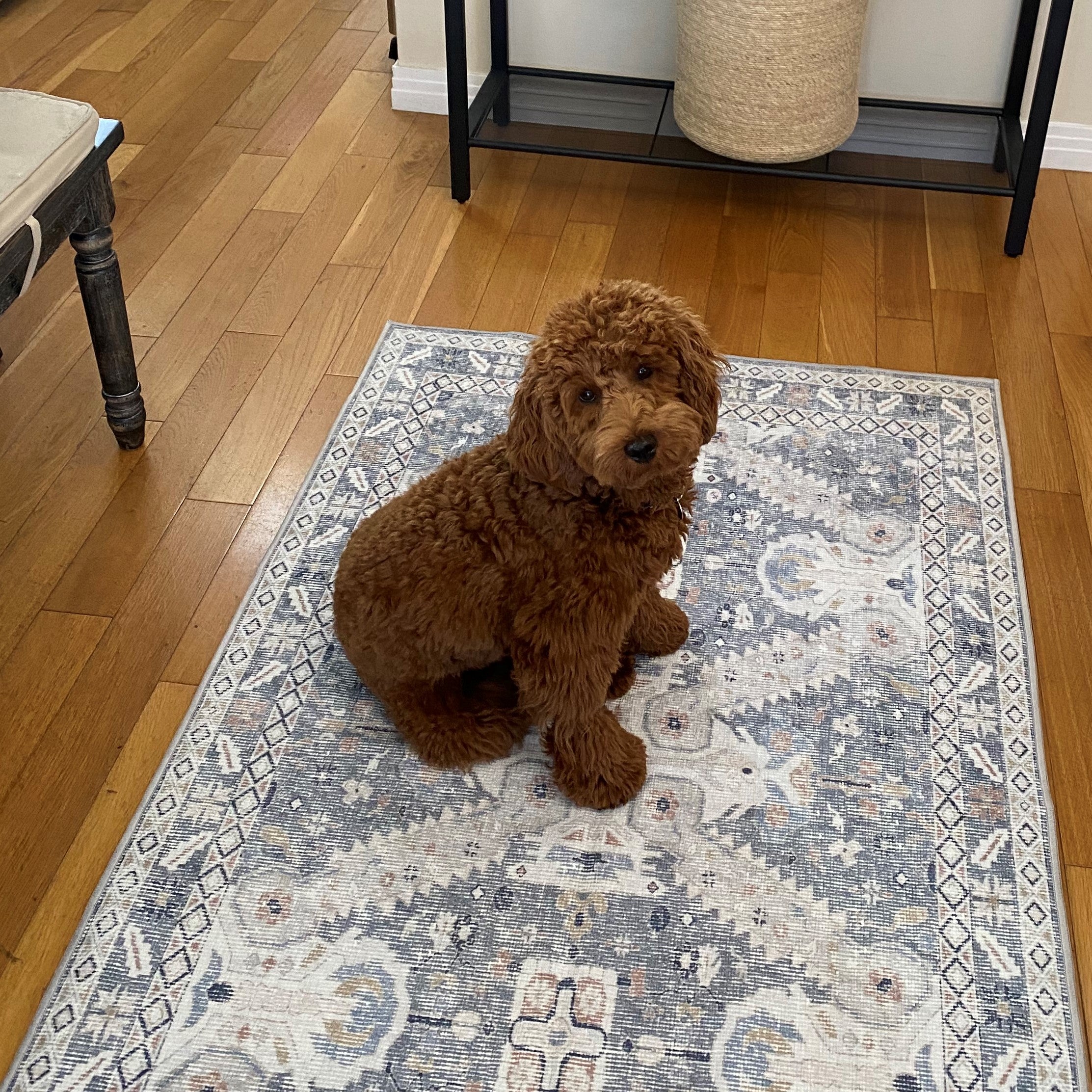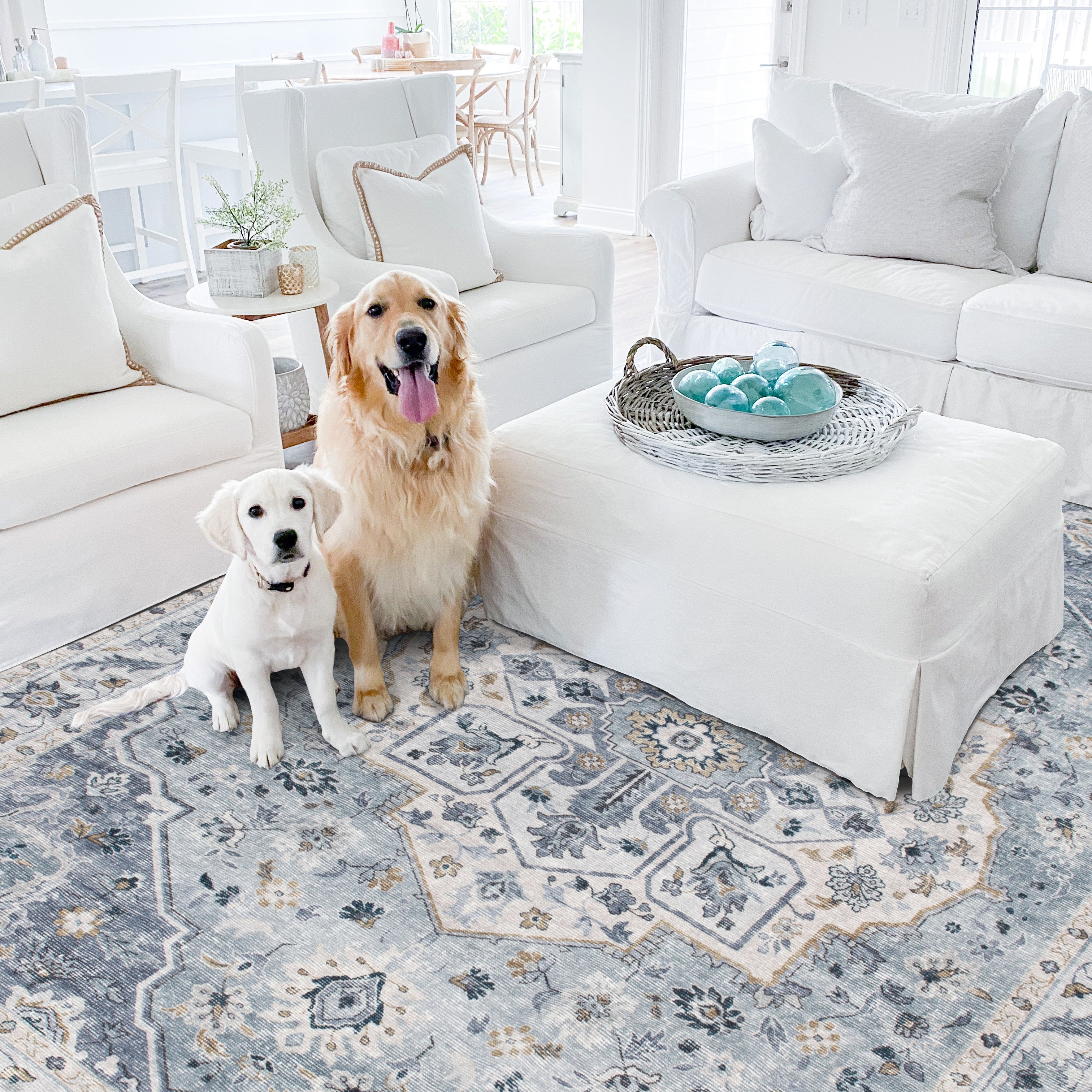Best Hypoallergenic Rug Choice for People With Allergies

If you struggle with allergies, there are probably many parts of your life you have to adjust to keep your symptoms at bay. One thing you may not have considered, however, is how a rug can contribute to your allergy symptoms.
In fact, there are some studies that explore whether or not carpets can impair the air quality in your home, and even negatively impact your health. But sticking to hardwood or laminate floors can sometimes interfere with your ideal home aesthetic and really bring down the overall cozy factor of your space.
If you already have to be mindful of your allergies in other areas of your life, it can be really frustrating to feel like your allergies are getting in the way of the home decor of your dreams.
Luckily, there are some ways to ensure that the rug you’re bringing into your home will be hypoallergenic — or at least gentle on your allergies. That way, you can feel comfortable in your home on every possible level, which is so important. Especially if you’ve moved into a new place and are trying to feel as at home as possible without exacerbating your allergies, we’re here for you!
Let’s talk about the best hypoallergenic rug choices out there, and what to look for in a rug if cutting back on allergens in your space is a major priority for you.

How Do Rugs Cause Allergies?
In general, unless you have an allergy to a specific type of fabric, you’re not likely to literally be allergic to your rug. However, because rugs tend to be in high-traffic areas, and come into contact with people, pets, and all the bits and pieces you track in from outside and elsewhere in the house… you can definitely be allergic to the things that rugs tend to collect.
Dander, dust mites, bacteria, and even molds and mildew can easily get into the fibers of your rug throughout the day. Particularly if you have a high pile rug like shag, all sorts of innocuous little things can get trapped in those fibers, which then get stirred into the environment and air when you walk over them or spend time near them.
This can make your rug a minefield if you struggle with allergies. And although your rug may look amazing in your room, it may not seem worth having if you find yourself fighting off allergy symptoms on a daily basis.
What About Off-Gassing?
Another common concern people have when it comes to allergy symptoms related to a new rug is something called off-gassing. The idea is that when you unroll a new rug, potentially volatile chemicals are released, which can negatively affect the air, environment, and your health.
This can happen with rugs and other types of furniture, cosmetics, clothing items, and just about anything else you’d bring into your home. This might sound familiar if you’ve recently gotten a new mattress or rug, and you can smell that sort of chemical odor that permeates the room for a small amount of time before it all evens out.
While in general, there isn’t much research about off-gassing being a serious concern either way, it’s worth prioritizing rugs that don’t use potentially hazardous chemicals or fibers. Tumble rugs are tested in accordance with US safety standards for any potentially dangerous chemicals like PFCs, VOCs (the ones most associated with off-gassing), Lead, Phthalates, Formaldehyde, and others.
Whether or not off-gassing is a concern for you, if you have allergies or asthma and are prone to respiratory irritation, sticking to a Tumble rug that is free of potentially irritating chemicals is a great way to ensure that your rug doesn’t exacerbate your allergies.
What Should You Look for in a Hypoallergenic Rug?
In addition to avoiding rugs that may contain toxic chemicals that can off-gas into your home and irritate your respiratory system, there are some other things to consider when you’re looking for a hypoallergenic rug.
Particularly if you’re living at an uneasy truce with a dog or cat and its hair and dander, choosing the right rug is crucial for keeping your allergy symptoms minimal. This goes double if you’re planning to place your area rug in a high-traffic area like your living room. Let’s talk about the three most important factors that go into keeping a rug hypoallergenic.

1. Be Mindful of the Materials
Not only is it important to ensure that the rug you’re purchasing isn’t made or treated with any toxic chemicals, but choosing a rug made from specific types of fibers can really help cut down on potential allergens.
Certain materials may be better for allergies than others. Wool, for instance, is naturally resistant to mold and mildew, and also makes it harder for dust mites and bacteria to settle into it because of its natural oils. Jute is also good for allergy sufferers.
That said, synthetic materials can be perfectly fine for allergies too! Our rugs are made from Polyester Chenille, which doesn’t have any noted effects on allergy sufferers. While being mindful of the materials that go into your rug is important, the next two points are even more key.
2. Select Something Low Pile
Overall, you’ll want to stick with low pile rigs. While high pile and shag rugs may feel soft and appealing, they’re especially good at trapping dust, dander, and the exact things that may trigger your allergies.
If you still want the look of a soft, luxurious rug even if it is a low pile, we’d recommend something like our Petra Rug, which comes in a gentle watercolor pattern that will give you that cozy feeling, without the dander. We also have options like our Hayden Rug, which has all the glamor and glory of a traditional Persian or vintage rug, with none of the risks to your allergies and comfort.
3. Prioritize Rugs That Are Easy to Clean
This is the big one when it comes to avoiding allergy symptoms!
Many rugs are extremely difficult to clean. While regular vacuuming can help cut down on any accumulated dust mites and dander, it’s not going to help if you, say, spill a drink onto the carpet. You can certainly absorb a lot of the spill and use carpet cleaning solutions to try to mitigate any stains, but it’s likely that liquid will seep into the carpet… leading to potential problems down the road.
Tumble rugs are spillproof — and unlike other waterproof products, they’re waterproofed with a nontoxic water-based solution. This means that if you spill something on a rug even as light and bright as our Canyon Rug, you don’t have to worry. The liquid won’t absorb into the rug itself, and you’ll be able to wipe it off with ease.

Additionally, Tumble rugs are machine washable. All you need to do is detach the rug from the rug pad, and toss it into the washing machine as you would any other household item. This eliminates the need for regular, costly trips to a professional cleaner. Not only does that make your life a whole lot easier, but it means that you can seriously cut down on allergens.
Particularly if you have a pet, you know that dander and dirt can get just about everywhere. With a low pile, machine washable Tumble rug, you’ll be able to clean your rug regularly so as to avoid the build-up of all the little things that can exacerbate your allergies and make your symptoms worse.
Keeping your home healthy and allergen-free can be challenging, especially if you want to bring a new textile to your space. But with a Tumble rug, it’s much easier than it’s ever been before!
In Conclusion
There are so many things to consider when it comes to adding a new piece to your home decor. If you struggle with allergies, not only do you need to think about which rug will best suit your space and personal tastes, but you also need to be sure you’re not bringing something into your environment that will make you wake up red-eyed and sneezing.
If allergies are a concern for you, we hope this advice on choosing a hypoallergenic rug will help you create the home of your dreams — without a single sneeze along the way.
Sources:
